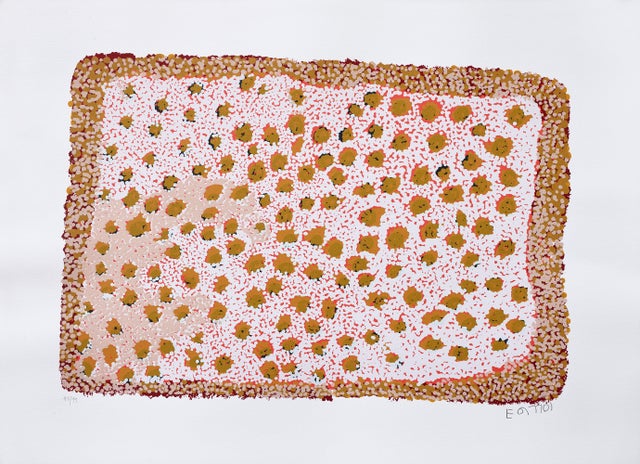- Yilpinji
- >
- Kantil Kantil - Elizabeth Nungarrayi Nyumi
Kantil Kantil - Elizabeth Nungarrayi Nyumi
Kantil Kantil - Elizabeth Nungarrayi Nyumi
Screenprint on Paper, $450
Edition size 99
Printer: Theo Tremblant assisted by Barak Zrlig
Studio: Editions Trembley NFP, Bungendore NSW
Acetates created at Warlayirti Artists, Balgo Hills WA June 2002
Print published Bungendore NSW June 2003
Paper Magnani Incisioni, 300 gsm white
Paper size 560 x 760mm
Image size 335 x 500mm
AAPN ID# EN001
Elizabeth, when asked about Love/Magic, depicted her father's country known as Parwalla. it is located far to the south of the Balgo in the Great Sandy Desert, west of the community of Kiwirrkurra.
The landscape of the area is dominated by tali or sand hills. Parwalla is swampy, filling a huge area with water after the wet season rain. These wet season rains result in an abundance of good bush tucker.
Depicted here is kantjilyi, or bush raisin surrounded by tali or sand hills. Both men and women collect bush raisins with each other. It is an activity said to bring men and women together. The bush raisin is high in protein and is thought to have beneficial healing properties for women's complaints.
While ‘Love Magic’ does exist in traditionally oriented Indigenous Australian communities in a variety of different ways, including visual art, ceremony, lengthy narratives, song and dance, it’s purpose seems to be widely misconstrued. Given that it is an umbrella translation for terminology from many different Indigenous Australian languages.
This artwork is part of a series using the Warlpiri and Kukatja word, Yilpinji, untranslated, rather than the misleading English hocus locus ‘love magic’. Why do indigenous societies practise Yilpinji. In traditional Australian life, there was a rigid system of arranged or ‘promised’ marriages, which to some extent continues to this day. Essentially marriage was an arrangement transacted between families, normally excluding what we now understand as ‘romance’.
’Yilpingi’ or socially authorised adulterous liaisons, which occur within a strict framework of rules, gives scope for the expression of romantic feelings and sexual love, without threatening the marriage system.
However it is quite clear that there is an inherent danger in Yilpinji-mediated relationships. Such unions could easily lurch out of control and therefore threaten normative marriage practises and rules. Hence the Yilpinji Dreaming narratives about illicit, transgressive love affairs, which as warnings and cautionary tales.

